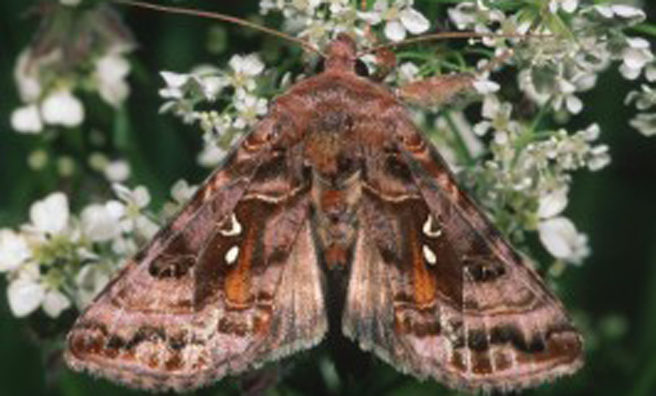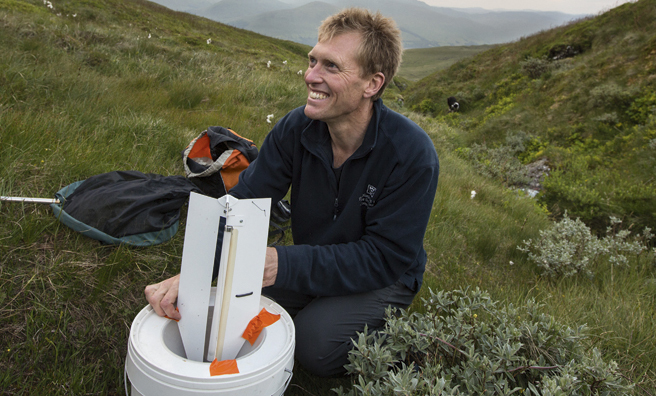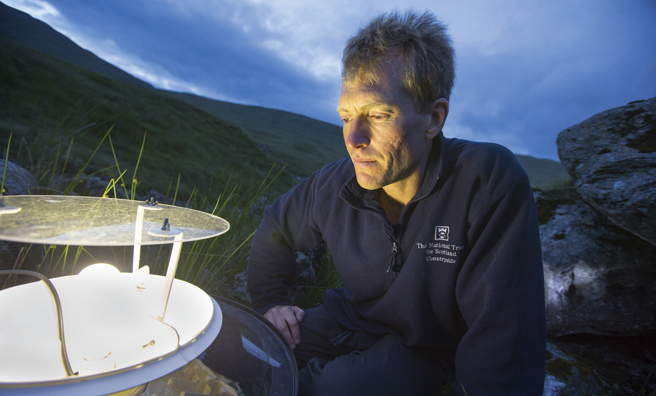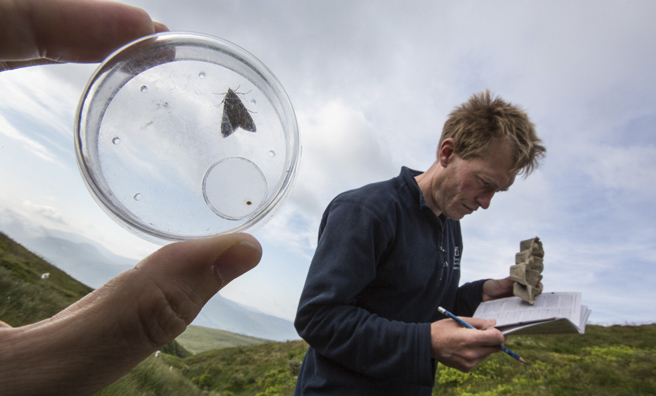Moths and Munros
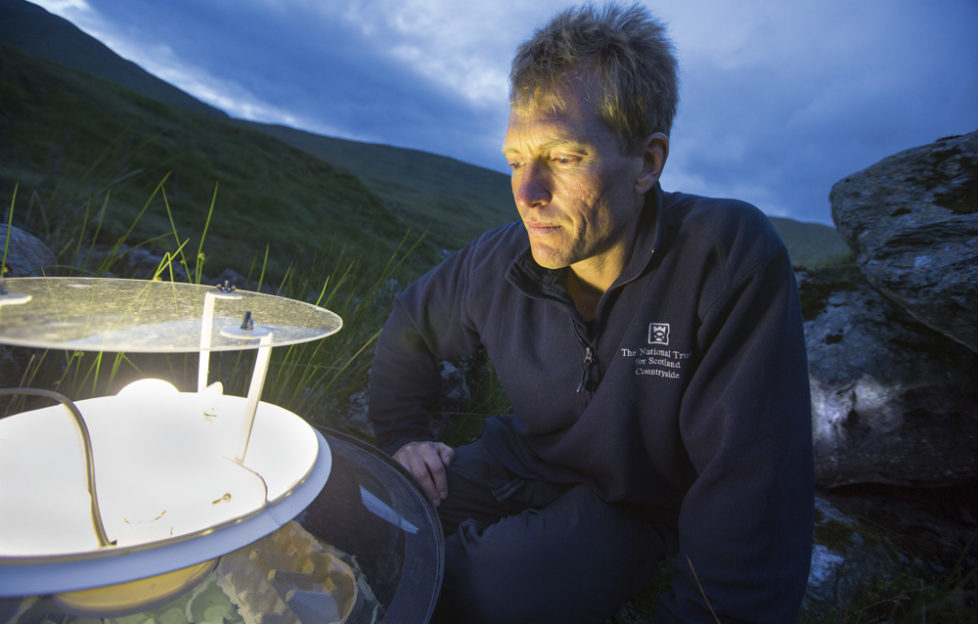
Going on a hill walk with Dan Watson can be fairly removed from a typical day among Munros, burns and lochans.
For a start, he can sometimes be found in the dead of night more than 2000 feet up the slopes of Ben Lawers carrying a white plastic bucket.
Dan is a moth hunter, at least for part of the time. His real title is an ecologist with the National Trust for Scotland. An important aspect of his job is monitoring the welfare of moths – and the best way to do that is to catch them.
Sometimes that means setting moth traps more than 800 metres up the Highland peaks – at night. The grass and heather next to the Lawers Burn is his equivalent of an office, where he then pitches his tent and waits for the morning light to see what he has caught.
He admits this part of his job is “weird”
While stressing he does do more normal tasks during the day, such as recording the progress of plants, he admits this part of his job is “weird”.
Overall, Dan keeps a check on the habitat of the Ben Lawers National Nature reserve, and the species living in it, to make sure outside interference such as global warming or too much sheep grazing is not having a detrimental effect.
He says, “The bulk of the work is carried out on behalf of Scottish Natural Heritage – there are various features which are designated, different habitats that are important in a European context.”
Of the overnight catching of moths, he adds, “What makes this job fun for me is the opportunity to do these extra bits, such as moth-trapping. Camping out is one of the extra things that is worthwhile.”
The plastic bucket he carries has a little strip light powered by a small car-type battery and a funnel to guide the moths down. Inside are cardboard egg boxes which allow the little creatures to cling on to something.
With darkness coming, another much larger trap is placed lower down the hill, near the tent. This is slightly more high-tech with a generator to power a mercury vapour bulb which looks as if it would not be out of place in a lighthouse.
The highlight of the day is spotted – a small Crambus Ericella
It is this regenerated area that Dan hopes will have provided a good habitat for the moths. With a big net over the top of the bucket each moth is carefully picked out before being set free to fly over the mountainside. Romantic names given by Victorian botanists such as True Lover’s Knot and Yellow-ringed Carpet are jotted down. But it is on the steep descent, his son Fred and collie dog Riddle in tow, that the highlight of the day is spotted – a small Crambus Ericella, never seen in the area before.
Mr Watson’s net comes to good use as the tiny moth is caught and identified with what amounts to an ecologist’s whoop of, “That’s a good find!”
Back by the Lawers Burn, while most of Perthshire is still asleep, the larger trap reveals more finds including the oddly named Beautiful Golden Y and Dark Brocade. Then the tent is packed up and it’s back down to the lochside – a day’s work finished before most offices are even up and running.
The value of protecting vitally important wildlife sites is incalculable
For Dan, the value of protecting vitally important wildlife sites such as the Ben Lawers National Nature Reserve is incalculable but the attraction of moths also has a personal element.
“Personally, I look at moths because as an invertebrate group they are relatively easy to identify. Because we know what their food plants and habitat requirements are, we can infer a lot from what species are present. They are being used nationally as a good indicator of habitat quality.”
It is habitat quality which is really the key. In the south of England, a decline in larger moths has been put down to a loss of areas where they live because of urban sprawl and rising temperatures hindering some plant growth.
“If you have good diversity of any species group, that provides evidence that you are doing something right with the habitat,” says Dan.
On Ben Lawers that means fencing off some areas to allow regeneration and managing grazing by sheep on the land.
In Scotland, the habitat is in a better shape than many areas in England
In Scotland, the habitat is in a better shape than many areas in England but monitoring is needed to make sure conditions don’t slip.
“We have found a fairly rare upland moth [Crambus Ericella]. That makes me happy, which is probably unscientific but I always like it when I find something that hasn’t been seen here before.”
Many moths live for only four or five nights
Many moths live for only four or five nights – their patterned wings used to mate before they die. Other species, however, survive over winter, even in the Scottish Highlands. The science of monitoring them includes the use of lights to attract them, but Dan has to admit no-one really knows why it works.
He says one theory is that they mistake the light for the moon, which could be used to navigate by keeping it on one side. Because a light bulb is much closer they end up flying round and round it to keep it on the same side.
He adds, “As far as I know there is no proof – and I am not convinced by it.”
Moths are also often misrepresented as being some kind of dangerous pest that will cause havoc, especially if they get in to your house. But the idea that they are outside a window at night, waiting to invade a wardrobe full of dresses and suits, is a bit of a myth.
Mr Watson explains, “There is a tiny handful of species of which the larva will eat your clothes.”
There were only ever a few types of moth that would want to eat clothes, but the synthetic fabrics found in most modern garments means the need for moth balls is not as great as it once was.
Rather than writing these creatures off as crazy light-botherers, or clothing eating pests, Dan sees the wide diversity of moths flying around Scotland’s mountains when the sun goes down as a sign that our glorious countryside is in rude good health.
- A Beautiful Golden Y
- Settling down for a long night
- Dan is an Ecologist with the National Trust for Scotland
- Got one!
- Dan is an Ecologist with the National Trust for Scotland
Moths & Munros Facts
- There are thought to be up to 160,000 species of moths
- With their hairy bodies, they are very important plant pollinators
- Some moths live less than a week and never eat
- Munros are Scottish mountains of 3,000ft and higher
- There are 282 munros in total
- Ben Lawers, at 3,984ft, is 10th highest


